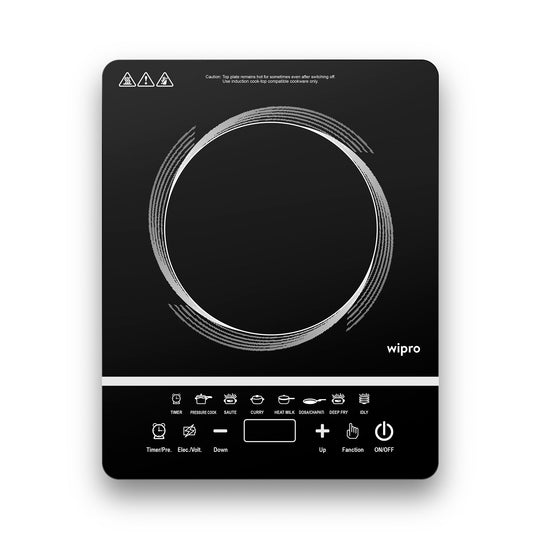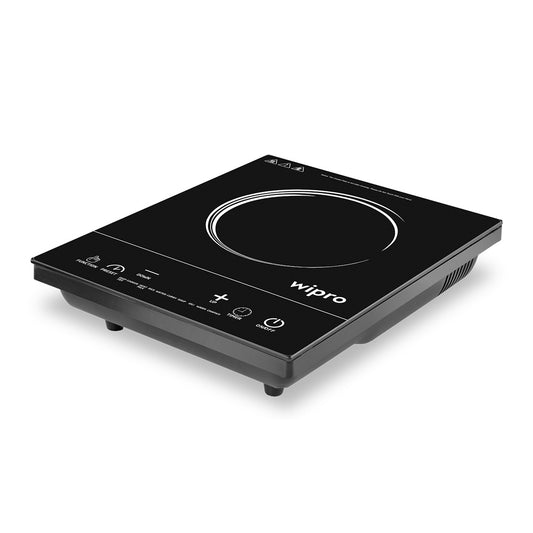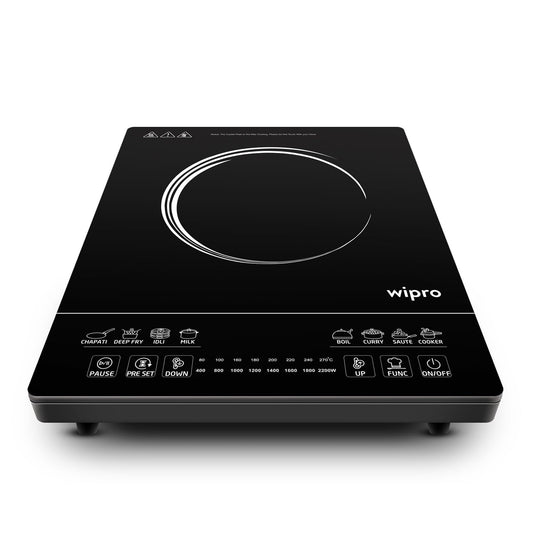Across Indian homes, the induction cooktop is steadily becoming a popular choice. Its speed, safety and sleek design appeal to both modern cooks and traditional households. Yet, several misconceptions continue to cloud its reputation. Is it really safe? Does it hike your electricity bill?
In this blog, we set the record straight on seven common myths and uncover the real uses of induction cooktops and their many benefits.
7 Induction Cooking Myths Busted
Myth 1: Induction Cooktops Are Dangerous
Many people assume that induction cooktops are unsafe because they involve electricity and invisible heat.
In reality, they are one of the safest kitchen appliances available today. Unlike gas stoves, induction cooktops have no open flame, and the cooking surface remains cool to the touch except directly under the pot. Most models also feature auto shut-off, reducing the risk of accidents if you forget to turn them off.
For added safety, the Wipro Vesta 2000 Watt Induction Cooktop comes with an automatic shut-off feature, making it a smart choice for families with children or elderly users. It’s a perfect example of how induction cooktop works efficiently while keeping your kitchen safe.
Myth 2: They Consume Too Much Electricity
A common misconception is that induction cooktops consume excessive power.
In fact, they are among the most energy-efficient cooking appliances. Since they transfer energy directly to the cookware through electromagnetic induction, very little heat is lost. Studies show that induction cooktops are up to 84% efficient, while gas stoves average around 40%.
The Wipro Vesta 2000 Watt Induction Cooktop features automatic shut-off, helping conserve energy and prevent unnecessary usage. So if you're concerned about rising power bills, know that induction cooking often uses less total energy due to shorter cooking times.
Myth 3: You Can’t Cook Indian Dishes
Some believe induction cooktops aren't suitable for Indian cooking styles that involve pressure cooking, frying, or making rotis.
However, modern models are built with preset cooking functions tailored for Indian meals. From boiling milk to making chapatis, tadka and curries, an induction cooktop can handle it all.
The Wipro Vesta 2000 Watt Induction Cooktop is designed with 10 inbuilt Indianized preset menus, making it easy to prepare dosa, idli, deep-fried snacks and more. This is one of the most practical uses of induction cooktops in Indian kitchens.
Myth 4: Only Expensive Cookware Works
It’s often believed that switching to induction cooking means investing in costly new utensils.
Not true. You only need flat-bottomed cookware with a magnetic base. Stainless steel, cast iron and triply cookware that are already common in Indian kitchens are typically compatible and widely available at affordable prices.
The Wipro Vesta 2000 Watt Induction Cooktop works efficiently with everyday induction- friendly utensils, proving that switching over doesn’t mean overhauling your entire kitchen setup.
Myth 5: Too Complicated to Use
Another myth is that induction cooktops are too technical or hard to use.
In reality, most models are designed for ease with simple controls. Features like touch buttons, timers and preset modes make the user experience intuitive even for those new to technology.
With the Wipro Induction cooktop, you get a user-friendly touch control panel and an easy-to-follow user manual, helping beginners cook confidently from day one. If you’re wondering how induction cooktop works, the answer is: smartly and simply.
Myth 6: They’re Slow to Cook
Many assume induction cooktops take longer to heat up compared to gas stoves.
The truth is the opposite. Induction technology heats cookware directly, eliminating heat loss and making cooking significantly faster. For instance, 1 litre of water can boil in just around 3 minutes.
The Wipro Vesta Induction Cooktop offers high-performance 2000W power, enabling faster cooking with up to 4x energy savings versus traditional cooking methods. This is one of the key benefits of induction cooktops for time-conscious households.
Myth 7: Induction Isn’t Suitable for Indian Kitchens
Some hesitate to switch to induction, thinking it won't handle the mess, heavy usage, or daily grind of Indian cooking. In reality, induction cooktops are compact, durable, easy to clean and highly adaptable. They’re great for apartments, urban homes and even areas with inconsistent gas supply.
The Wipro Vesta 2000 Watt Induction Cooktop features a crystal glass plate that brings elegance to your kitchen while ensuring easy maintenance and comfort. If you’re wondering about the uses of induction cooktops, they fit perfectly into both modern and traditional Indian cooking environments.
How Induction Cooktop Works: Expert Tips
To get the best results from your induction cooktop, follow these simple but effective tips:
- Use induction-ready cookware with a flat, magnetic base to ensure proper heat transfer.
- Opt for models that come with Indian preset menus to simplify daily cooking.
- Always clean the surface with a soft cloth to avoid using abrasive pads or harsh chemicals.
- Avoid using very lightweight or uneven-bottom vessels, as they may not activate the cooktop’s heating sensor.
For a seamless experience, the Wipro Vesta Induction Cooktop is an excellent choice. With smart features and user-friendly design, it makes everyday cooking easier, safer and more energy-efficient.
Conclusion
It’s time to stop letting outdated assumptions hold you back from a smarter, safer kitchen. With their fast performance, precise control and efficient energy use, the benefits of induction cooktops far outweigh the myths. They're ideal for modern Indian homes and everyday cooking needs.
Looking to upgrade? The Wipro Vesta 2000 Watt Induction Cooktop is a perfect fit designed for quick, healthy and hassle-free cooking tailored to Indian kitchens.






























































































































































































































































































































































































































































































































